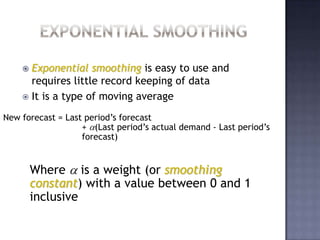IBM401 Lecture 12
- 1. Quantitative Analysis for BusinessLecture 12 – Final Exam ReviewOctober 4th, 2010http://www.slideshare.net/saark/ibm401-lecture-12
- 2. Final examNo. of questions: 3Duration: 3 hoursGrade: 50% of final gradeTopics:Everything
- 3. Linear regressionIdentifying independent and dependent variableThe sample correlation coefficient for two variablesLinear regression model form
- 4. Linear regressionThe assumptions of linear regression model are the following:A linear relations exists between the dependent variable and the independent variable.The independent variable is not random.The expected value of the error term is 0.The variance of the error term is the same for all observationsThe error term is uncorrelated across observations.The error term is normally distributed.
- 5. Linear regressionIn the regression model Yi = bo + b1Xi + Ei, if we know the estimated parameters, bo and b1, for any value of the independent variable, X, then the predicted value of the dependent variable Y is Y = b0 + b1XIn simple linear regression, the F-test tests the same null hypothesis as testing the statistical significance of b1 (or the t-test)H0: b1 = 0H1: b1 ≠ 0If F > Fc, then reject H0^^
- 6. Multiple regressionMultiple regression modelIntercept – the value of the dependent variable when the independent variables are all equal to zeroEach slope coefficient – the estimated change in the dependent variable for a one-unit change in the independent variable, holding the other independent variables contantY = 0 + 1X1 + 2X2 + … + kXk +
- 7. Hypothesis testing of regression coefficientst-statistic – used to test the significance of the individual coefficient in a multiple regressiont-statistic has n-k-1 degrees of freedomEstimated regression coefficient – hypothesized valueCoefficient standard error of bj
- 8. F-statisticF-test assesses how well the set of independent variables, as a group, explains the variation of the dependent variableF-statistic is used to test whether at least one of the independent variables explains a significant portion of the variation of the dependent variable
- 9. Coefficient of determination (R2)Multiple coefficient of determination, R2, can be used to test the overall effectiveness of the entire set of independent variables in explaining the dependent variable.
- 10. Adjusted R2Unfortunately, R2 by itself may not be a reliable measure of the multiple regression modelR2 almost always increases as variables are added to the modelWe need to take new variables into accountWheren = number of observationsk = number of independent variablesRa2 = adjusted R2
- 11. Adjusted R2Whenever there is more than 1 independent variableRa2 is less than or equal to R2So adding new variables to the model will increase R2 but may increase or decrease the Ra2Ra2 maybe less than 0 if R2 is low enough
- 12. Time-Series ModelsTime-series models attempt to predict the future based on the pastCommon time-series models areMoving averageExponential smoothingTrend projectionsDecompositionRegression analysis is used in trend projections and one type of decomposition model
- 13. Decomposition of a Time-SeriesA time series typically has four componentsTrend (T) is the gradual upward or downward movement of the data over timeSeasonality (S) is a pattern of demand fluctuations above or below trend line that repeats at regular intervalsCycles (C) are patterns in annual data that occur every several yearsRandom variations (R) are “blips” in the data caused by chance and unusual situations
- 14. Mathematicallywherewi = weight for the ith observationWeighted Moving AveragesWeighted moving averages use weights to put more emphasis on recent periods
- 15. Often used when a trend or other pattern is emergingExponential SmoothingExponential smoothing is easy to use and requires little record keeping of dataIt is a type of moving averageNew forecast = Last period’s forecast + (Last period’s actual demand - Last period’s forecast)Where is a weight (or smoothing constant) with a value between 0 and 1 inclusive
- 16. Exponential SmoothingMathematicallywhereFt+1 = new forecast (for time period t + 1)Ft = previous forecast (for time period t) = smoothing constant (0 ≤ ≤ 1)Yt = pervious period’s actual demandThe idea is simple – the new estimate is the old estimate plus some fraction of the error in the last periodExponential Smoothing with Trend AdjustmentLike all averaging techniques, exponential smoothing does not respond to trendsA more complex model can be used that adjusts for trendsThe basic approach is to develop an exponential smoothing forecast then adjust it for the trendForecast including trend (FITt) = New forecast (Ft) + Trend correction (Tt)
- 17. Exponential Smoothing with Trend AdjustmentThe equation for the trend correction uses a new smoothing constant Tt is computed bywhereTt+1 = smoothed trend for period t + 1Tt = smoothed trend for preceding period = trend smooth constant that we selectFt+1 = simple exponential smoothed forecast for period t + 1Ft = forecast for pervious period
- 18. Seasonal Variations with TrendWhen both trend and seasonal components are present, the forecasting task is more complexSeasonal indices should be computed using a centered moving average (CMA) approachThere are four steps in computing CMAsCompute the CMA for each observation (where possible)Compute the seasonal ratio = Observation/CMA for that observationAverage seasonal ratios to get seasonal indicesIf seasonal indices do not add to the number of seasons, multiply each index by (Number of seasons)/(Sum of indices)


















